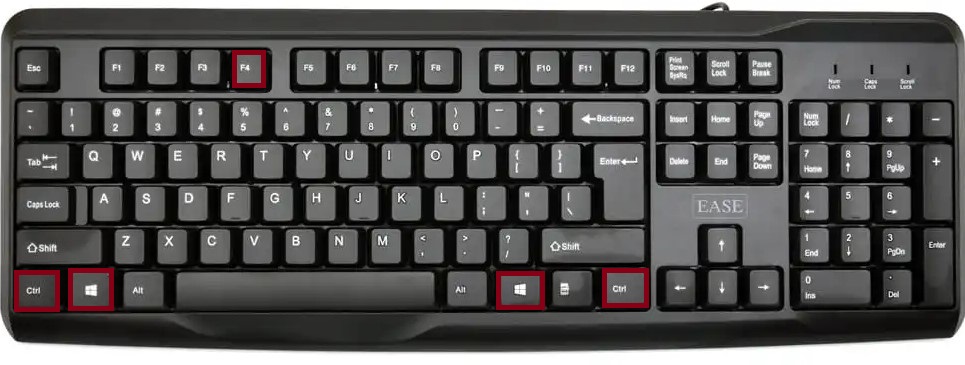The Windows + Ctrl + F4 keyboard shortcut is a powerful tool designed for closing the current virtual desktop in Windows without affecting the applications running inside it. This shortcut is part of Windows’ virtual desktop management features, introduced in Windows 10 and enhanced in Windows 11, enabling users to keep workspaces organized, multitask efficiently, and reduce clutter.
When you execute Windows+Ctrl+F4, the active virtual desktop will close, and all open windows on it will be moved automatically to the previous virtual desktop. This makes it easy to quickly clean up your workspace or consolidate tasks without manually dragging windows between desktops.
Table of Contents
Function of Windows + Ctrl + F4
In Windows 10 and Windows 11, Windows + Ctrl + F4 specifically:
- Closes the current virtual desktop.
- Moves all open apps from the closed desktop to the immediately previous desktop.
- Does not shut down or close your applications — it simply changes their location.
- Allows quick cleanup of unused virtual desktops without needing to open Task View manually.

How to Use Windows+Ctrl+F4
- Open multiple virtual desktops
- Press Windows + Ctrl + D to create a new virtual desktop.
- Navigate to the desktop you want to close
- Use Windows + Ctrl + Left Arrow or Windows + Ctrl + Right Arrow to switch between desktops.
- Close the active virtual desktop
- Press Windows+Ctrl+F4 — the current desktop will disappear, and all open apps will be moved to the one on the left.
Practical Uses of Windows + Ctrl + F4
- Cleaning up workspaces after a project without closing the apps.
- Quickly exiting a dedicated workspace for a presentation or meeting.
- Reducing distraction by consolidating all open windows into fewer desktops.
- Saving time by avoiding manual dragging of windows between desktops.
Use in Microsoft Applications
While Windows+Ctrl+F4 affects the Windows desktop environment rather than individual apps, it has indirect benefits for Microsoft software such as:
- Microsoft Word, Excel, and PowerPoint – Keep project-specific documents open on separate desktops, then close the whole workspace after finishing.
- Microsoft Teams – Keep Teams meetings or chat windows on a dedicated desktop for better focus.
- Microsoft Edge – Maintain research tabs on one desktop and close them as a group when the research session ends.
Use in Other Applications
This shortcut is system-wide, so it works regardless of the program you are using. Examples include:
Browsers (Chrome, Firefox, Edge)
Organize tabs in one desktop and close the desktop after the session.
Design Tools (Photoshop, Figma)
Create a distraction-free workspace for design projects and remove it afterward.
Development Environments (Visual Studio, VS Code)
Use one desktop for coding and testing, then close it when switching to documentation or presentation tasks.
Issues or Not Working
If Windows + Ctrl + F4 is not functioning, possible reasons include:
- Virtual Desktops not enabled – Ensure your Windows version supports them (Windows 10 and 11 only).
- Function key behavior – On laptops, you may need to press Fn + Windows + Ctrl + F4 depending on keyboard settings.
- Custom keyboard software interference – Key remapping tools might override this shortcut.
- Group policy restrictions – Some workplaces disable virtual desktop features for security or workflow reasons.
Troubleshooting Tips:
- Verify multiple desktops exist before trying to close one.
- Test in a clean user profile to rule out software conflicts.
- Update Windows to ensure virtual desktop improvements are available.
Mac Equivalent
On macOS, there’s no direct equivalent to Windows + Ctrl + F4, but similar functionality can be achieved using Mission Control:
- Press Control + Left Arrow or Control + Right Arrow to switch spaces.
- Close a space manually by opening Mission Control (F3 or swipe up with three/four fingers) and clicking the X button on the desired space.
Summary
The Windows + Ctrl + F4 keyboard shortcut is an efficient way to close an entire virtual desktop in Windows 10 and 11, moving its contents to another desktop without closing any applications. This feature is invaluable for organizing workspaces, reducing distractions, and streamlining workflow across projects. Whether you are a professional juggling multiple assignments or simply someone who likes a clean desktop environment, mastering this shortcut will make your Windows multitasking experience much smoother.